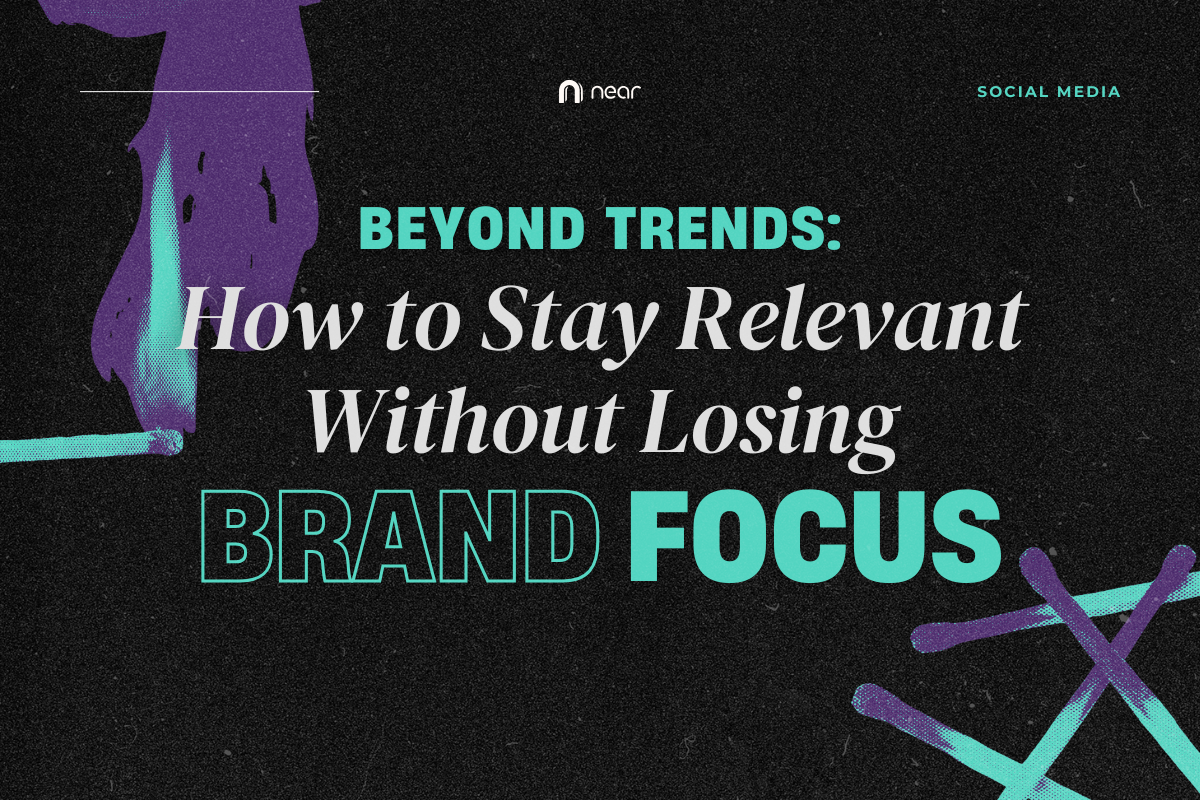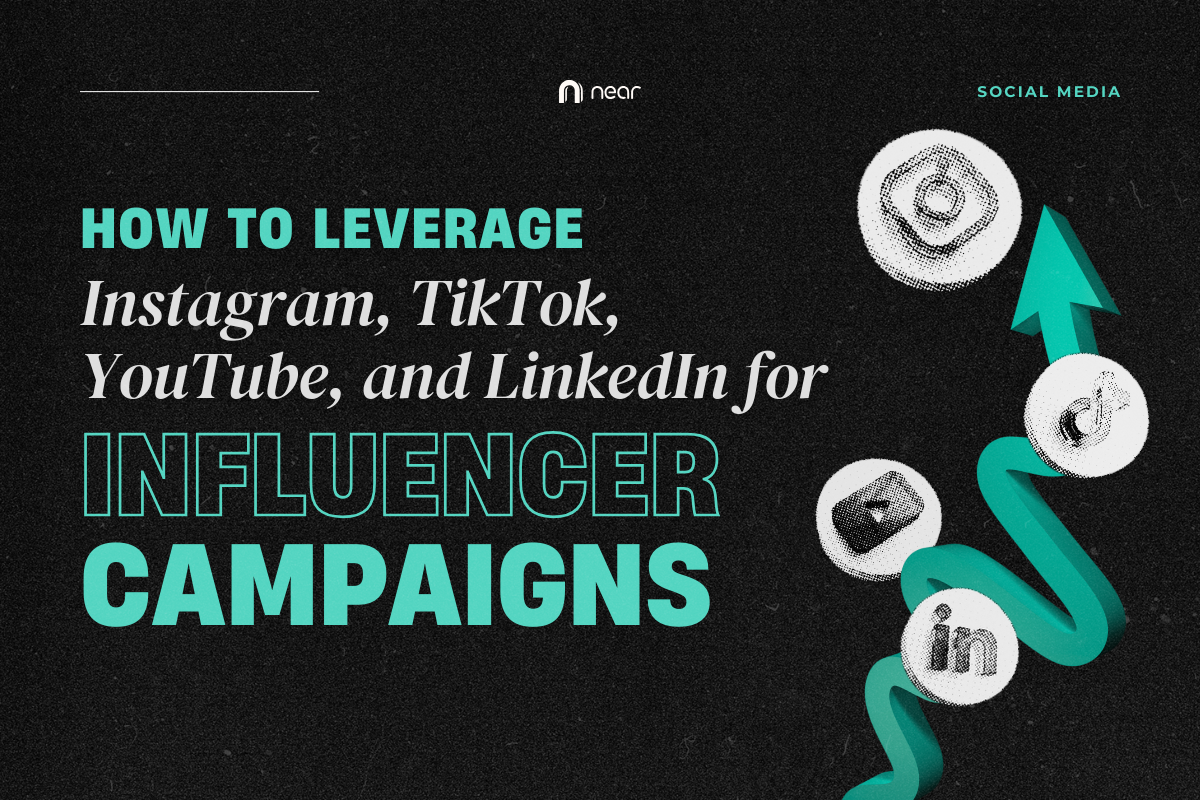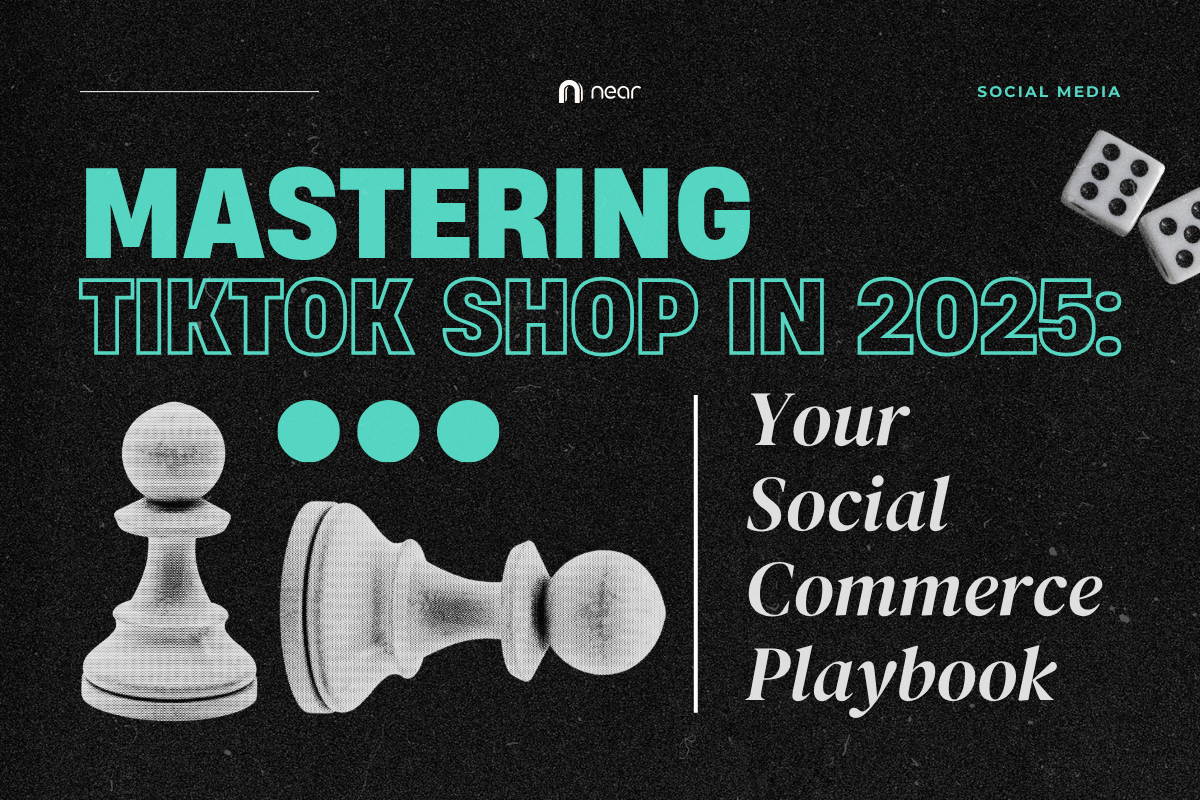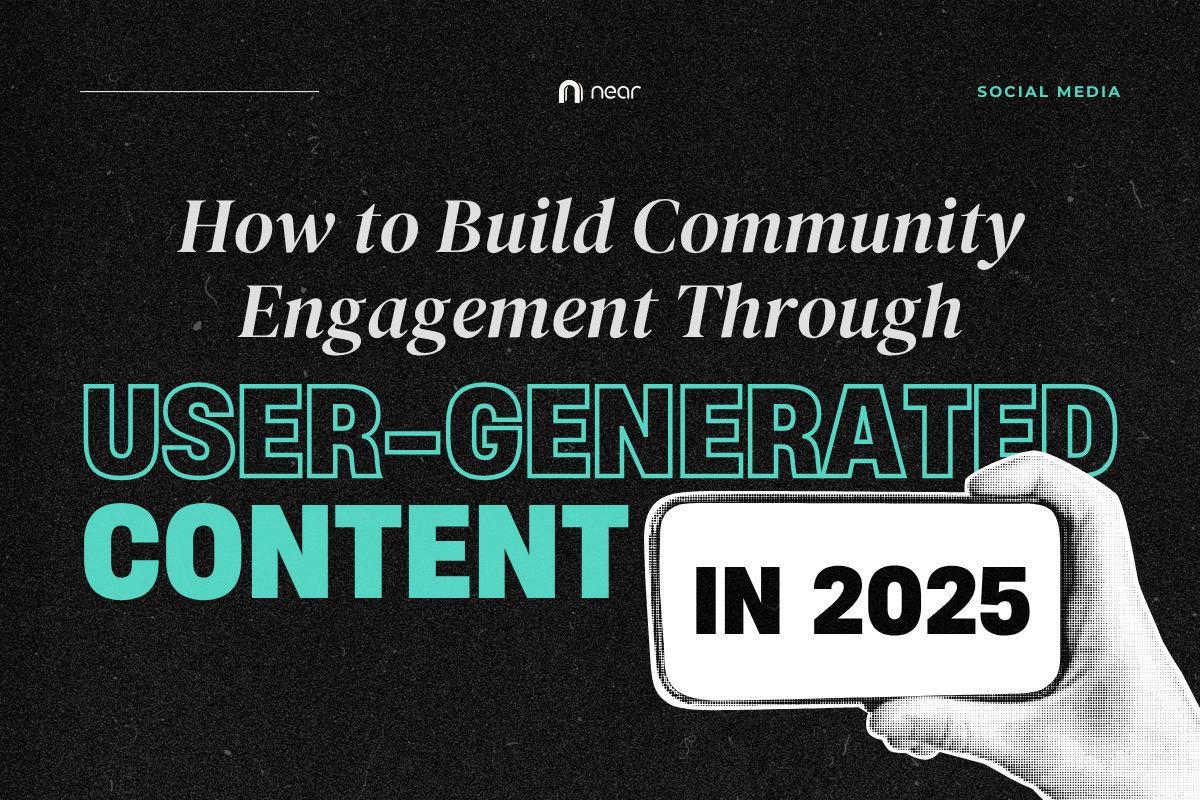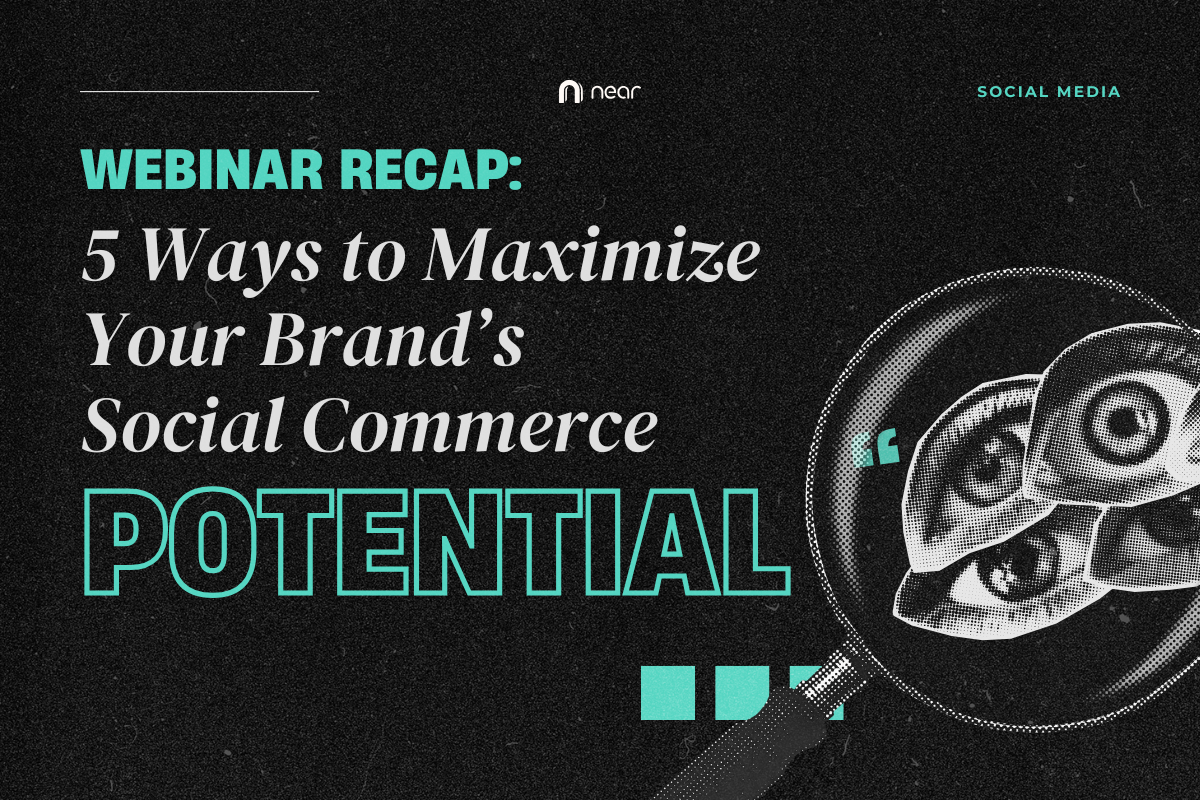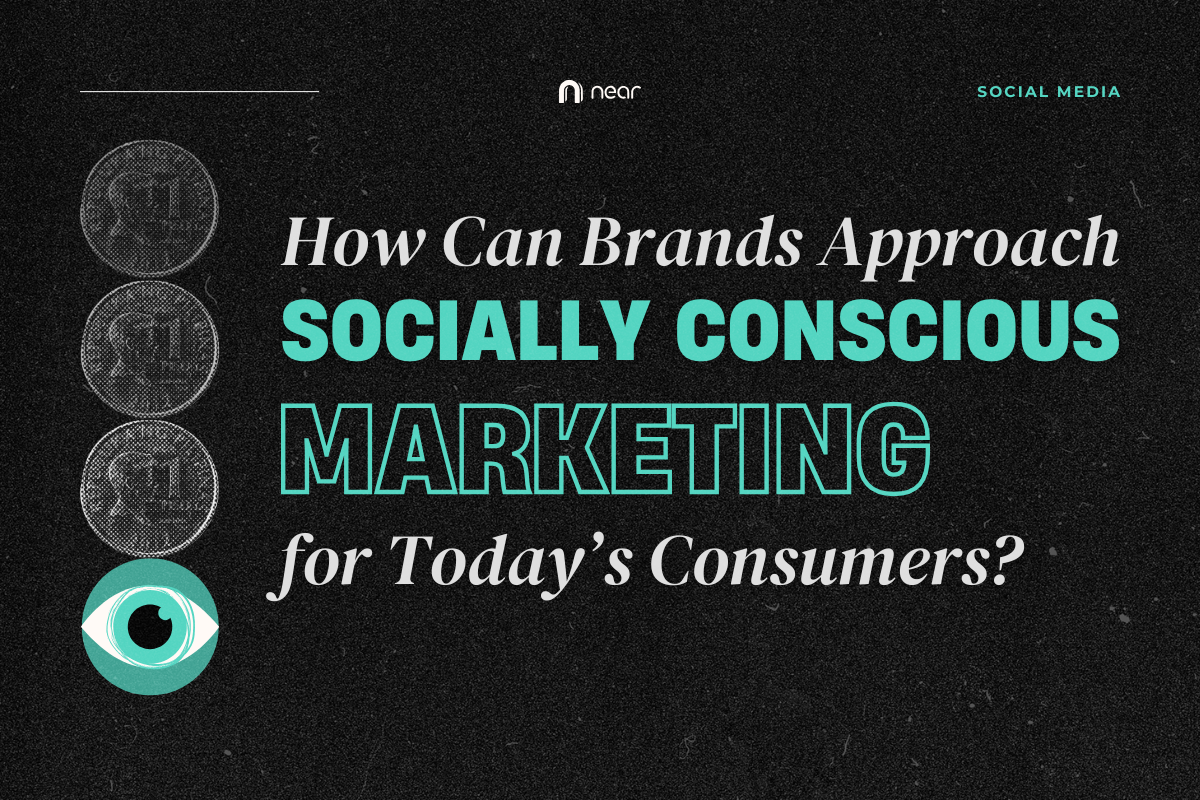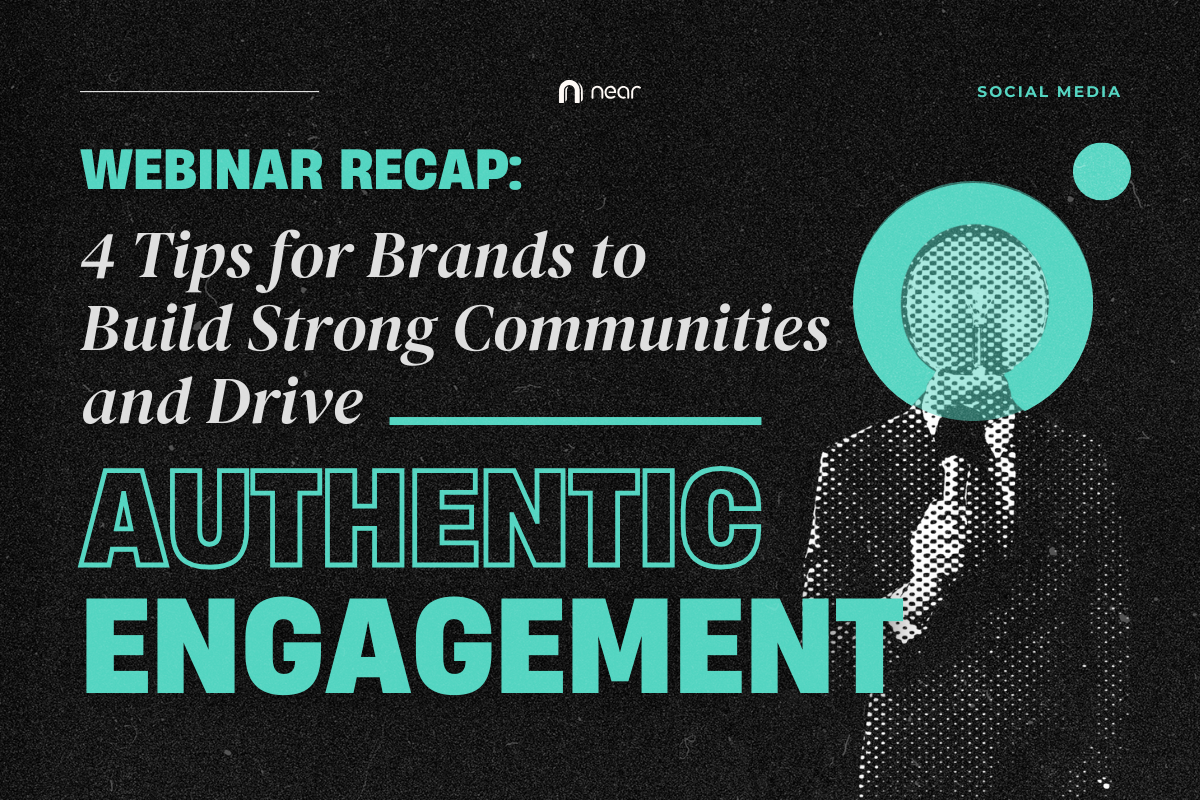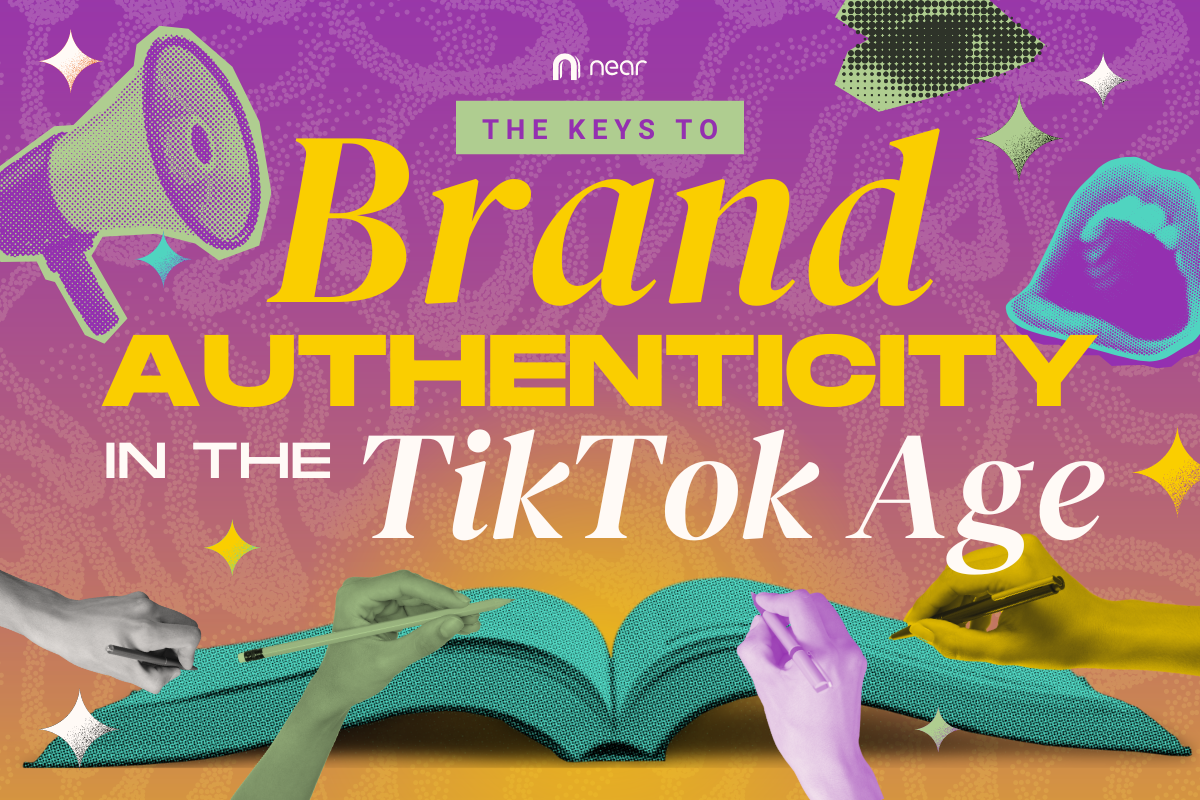View By Date
- December 2025 1
- November 2025 2
- October 2025 3
- September 2025 2
- August 2025 2
- July 2025 2
- June 2025 2
- May 2025 3
- April 2025 2
- March 2025 3
- February 2025 1
- January 2025 1
- November 2024 1
- September 2024 1
- July 2024 1
- May 2024 3
- April 2024 1
- March 2024 1
- February 2024 2
- January 2024 2
- August 2023 1
- July 2023 1
- June 2023 2
- May 2023 3
- April 2023 4
- January 2023 2
- November 2022 1
- September 2022 3
- June 2022 1
- December 2021 1
- November 2021 4
- October 2021 2
- September 2021 1
- January 2021 1
View By Category
3 Steps to Effective Influencer Briefs Without Losing Creativity
3 Steps to Effective Influencer Briefs Without Losing Creativity
Your brand has 15 pages of guidelines. Your influencer has 15 seconds to sound authentic. The friction between brand control and creator voice is the central tension of every campaign, and it's why your influencer brief isn't just a document, but the blueprint that either grants creative freedom or guarantees a flop. You’re not just writing instructions, you’re also shaping how your brand shows up through another person’s voice. Yet, this crucial document is often treated like a rigid ad script, forgetting the core of creator-led content: authenticity.
Whether you're building a TikTok-first campaign or working with mid-tier Instagram creators, one thing is clear: authenticity drives results. And that starts with a smarter brief.
Let’s break down the three essential steps to writing an influencer brief that aligns with your brand and plays to a creator’s strengths backed by best practices from the creator economy.
Step 1: Build the foundation and not just the script.
A common pitfall? Over-writing the brief like it’s a TVC. Brands often go overboard with talking points, restrictive do’s and don’ts, and content that reads like a product manual.
Imagine a brief that specifies: "In the 1st second, hold the packaging with your thumb on the logo. From 3-5 seconds, state key benefit 1 ('₱100 OFF on your first order') while pointing at the screen. End the video with a mandated, unskippable call-to-action to click the bio link now, using only our specific link text." Nope, we don’t like that.
Here’s what not to do:
Force influencers to follow a rigid script
Prioritize features over stories
Ignore the creator’s tone and audience
Over-police visuals, captions, and hooks
Instead, approach the brief like a collaborative blueprint. Provide them with clarity and not with control.
The Essential Brief Foundation Checklist
Instead of over-scripting, focus on providing a clear brand foundation using these five essential elements:
Brand & campaign overview: What’s the product, purpose, and positioning?
Audience fit: Who are you speaking to and why is this creator a match?
Key message pillars: Not full lines, rather just the must-mentions and value props
Visual direction & sample content: Give examples that match your tone, without boxing them in
Deliverables & deadlines: Be specific about formats, platforms, and timelines
Your brief must act as the strategic document that channels creative talent toward measurable goals, because, “Creativity without strategy might impress, but it won’t convert. Start with insight, not instinct.” - inBeat
Step 2: Leave room for platform-native creativity
Once your strategic foundation is rock solid, the next step is ensuring that your message translates authentically to the creator’s native environment. Your creators know their platform better than you do, so let them lead the way. Great content is built for the platform it lives on. TikTok needs fast hooks and trending audios. YouTube Shorts might need stronger storytelling flow. Instagram Reels rely on visuals and transitions. And influencers? They’ve already cracked that code.
How to empower influencers through your brief:
Set guidelines, not guardrails: Give product details, but let them shape the narrative
Match content types to creator strengths: Is it unboxing, POV, testimonial, or transformation?
Encourage organic mentions: Ditch the “say this line exactly” rule\
Trust their format instincts: Let them use trending audios, native hooks, and caption styles
Being intentional means your brief can't be a one-size-fits-all document. It requires you to do your homework and tailor key elements of the request to each individual creator. Take it from Bobabam’s Molly Savage via Superfiliate:
“Be intentional. Personalize the brief for each creator and match the format to what actually performs on their page.”
For example, in our KOL campaign with InLife, creators weren’t handed uniform scripts, they crafted TikToks around their own budgeting hacks and financial experiences. The result? Relatable, real content that made financial literacy feel fresh and not forced.
And remember: brief differently depending on the content’s use. Organic collab? Keep it light. Planning to boost or run it as paid ads? This shifts the entire legal and strategic scope, requiring clarity on two crucial components: Usage Rights (legal permission to use the content in your marketing channels) and Creator Whitelisting (giving the brand permission to run the ad directly from the creator's handle to leverage their social proof and audience targeting).
Step 3: Align expectations, but keep it humanized.
Lastly, the best briefs strike a balance: clear expectations and enough space for the creator to surprise you. Include the practical bits:
Deliverables (Reels, TikToks, Stories, etc.)
Posting dates & timelines
Caption/hashtag requirements
Key do’s & don’ts (e.g., avoid profanity, no direct competitor tags)
But also include:
Brand tone: Is your brand cheeky, empowering, expert, or minimalist?
Campaign goals: Are we going for reach, clicks, or community building?
Compensation terms: Include if it’s paid, gifted, commission-based, or long-term
Always remember to encourage feedback, because briefs that invite collaboration build long-term trust both with brands and creators, and eventually… better results.
In our Spotify Daylist campaign, creators were simply prompted to interpret their mood-based playlists. No hard scripts. Just real talk and a meaningful relationship. That flexibility is what sparked viral relatability. Read more about it on our blog about How to Cultivate Meaningful Long-Term Relationships with Influencers.
Key Takeaways: Writing Briefs That Perform
To make your briefs collaborative springboards instead of rigid scripts, focus on these three key takeaways:
Set Direction, Not Limits:
Clarify your brand goals, product positioning, and audience, but avoid scripting every word.
Let the creator own the story while aligning with your core message pillars.
Think Platform-First:
Different platforms demand different styles (e.g., TikTok vs. LinkedIn).
Brief accordingly by matching the format to the platform's native style for maximum impact.
Create Clarity through Collaboration:
Be specific with deliverables, usage rights, and timelines.
Always allow room for the creator’s unique perspective and platform-native creativity.
A great brief is both informative and inspiring. It empowers creators while keeping your brand’s priorities front and center.
Want to co-create briefs that convert? Download our Social Media Trends Guide for actionable tips on staying relevant, authentic, and ROI-ready.
3 Steps for Brand Marketers to Trend Jacking That Works
3 Steps for Brand Marketers to Trend Jacking That Works
When it comes to digital marketing, the question isn’t if you should participate in trends, it’s which ones are worth jumping on. In a creator-led landscape and platforms like TikTok, where culture moves at lightning speed, trend-jacking can either elevate your brand into the spotlight or tank it with one misstep.
So how do you know what’s worth riding, what’s already stale, and what will actually work for your brand?
This blog will guide you through a smarter, more strategic approach to trend-jacking, one that balances speed with brand alignment, culture with data, and short-term attention with long-term equity. Whether you’re managing a brand’s daily content calendar or shaping seasonal campaigns, trend selection is more than just spotting a viral audio. It’s about building cultural relevance without losing your brand’s focus and voice.
Step 1: Discover and Evaluate Potential Trends
Trends can be powerful tools for connection but only if they align with your audience and brand DNA. Here's how to spot them early and evaluate if they’re worth the ride. Trend-jacking only works if it’s both timely and relevant and that “too late” can often mean “too noisy.”
Monitor smarter:
Use social listening tools like Sprout Social or TikTok Creative Center to spot rising formats, hashtags, and creator movements before they peak.
Tap into cultural calendars! Think album drops like Taylor Swift’s “The Life of a Showgirl”, award shows like the Oscars or MMFF, and sporting events like the Olympics or NBA Finals that can spark niche conversations tied to your brand. Don’t forget recurring moments like International Coffee Day (October 1), Pride Month (June), or 11.11 Sales. These trends are goldmines for moment marketing!
Go beyond the “what” and ask “why” a trend resonates. For example, the viral Girl Dinner moment, it wasn’t just about food but it also reflected burnout, autonomy, and anti-perfectionism narratives that many brands could’ve built on.
Use a trend filter by answering these questions before acting:
Relevance: Is this connected to our brand’s mission or is it a random grab for attention?
Timing: Are we early enough for our version to feel fresh and not fatigued?Audience: Does this speak to our core demographic, or is it outside their bubble?
Risk: Are we stepping into a sensitive topic? Are we prepared to stand by our message?
Step 2: Plan Your Trend Integration
Once you’ve vetted a trend, the next move is not to copy-paste what everyone else is doing… but to remix it with your brand’s voice. Here are some tips to do that:
Define your POV.
The same trend can hit differently when filtered through the right tone. What matters is how you show up in the conversation. Take the “deinfluencing” trend, where creators called out overhyped products. A luxury skincare brand might lean in by spotlighting minimalist routines and promoting science-backed transparency: “Not everything belongs in your shelfie.” Meanwhile, the “girl math” trend, originally about humorous justifications for spending, became fertile ground for financial brands. A fintech app could ride the trend with cheeky skits showing how “investing P500 today is basically free money in 5 years,” turning humour into a teachable moment. Even the “Hot Girl Walk” trend was reinterpreted by different brands: from beverage brands promoting hydration must-haves to podcast channels encouraging intentional movement as self-care.
Choose your platform and timing wisely.
Not every trend belongs everywhere. A meme-heavy trend might live best on TikTok, while a stat-backed commentary is better suited for LinkedIn. Use platform-native behavior to inform your content angle and don’t just wait for trends to land on your feed. Set a regular trend-spotting schedule, like weekly or bi-weekly check-ins, to proactively find emerging moments and plan ahead instead of reacting late.
Empower creators, don’t restrict them.
Trend-jacking works best when brands let creators interpret trends their way. Not every video needs your logo in the first second. Trust creators to keep it real, that’s why their audiences trust them in the first place. Take our work with Spotify’s Daylist campaign, where we tapped into the trend of hyper-personalized content through KOL TikTok videos showing oddly specific moods or routines. People then joined the trend by sharing their own mood-based playlists in relatable formats with no hard scripts.
Or look at InLife’s Campaign, which trend-jacked the POV storytelling format popular among Gen Z. Creators used skits and casual monologues to give financial advice making insurance and money matters feel fresh and relevant.
“The most effective trend-jacking comes from understanding platform language and creator culture, because audiences can tell if you’re a tourist.”
Step 3: Execute Fast and Measure Smarter
Trend-jacking requires us to be fast but you should put in mind that success measurement shouldn’t be shallow. A great example of a campaign that mixes both? See how Spotify partnered with creators to drive platform-native, full-funnel campaigns that worked across TikTok and YouTube. By loosening the grip, brands gain traction that feels earned, not engineered.
Don’t just track impressions, in terms of metrics, track the impact.
Did people share it organically?
Did it drive profile visits, clicks, or conversions?
Did it shift brand sentiment or spark meaningful conversation?
Check for emotional signals.It’s easy to get caught in views and likes. Through meaningful reactions such as DMs, stitches, shares with captions, these tell you whether your brand message landed because of the trend. Tools like sentiment analysis and UTM tracking will help you map attention to action.
Balance the reactive with the evergreen.Trends might win the moment, but your brand still needs consistency. Use trend content to spark discovery, and evergreen content to sustain loyalty.
Key Takeaway: Don’t cloutchase, trend smarter!
Here’s your 3-step takeaway to help you trend-jack with purpose:
Stay ready, not reactive. Set up listening tools and keep a bank of trends and content angles that resonates with your brand. Certain trends may also need tweaking based on your brand’s tone guidelines.
Be bold and on-brand. If it doesn’t align with your audience or values, skip it. One ‘right-fit’ trend is more valuable than five random ones.
Partner with influencers wisely. Let KOLs translate trends in their voice, not yours. You are aiming to earn engagement, not eye rolls! Trust the KOLs and know the right fit to do these trends for your brand.
Want your next campaign to ride the trend waves instead of drown in it? Download Near’s Influencer Trends Guide to spot trends that actually fit your brand and build influencer campaigns that convert.
Category: Social Media
Beyond Trends: How to Stay Relevant Without Losing Brand Focus
Beyond Trends: How to Stay Relevant Without Losing Brand Focus
Chasing social media trends has become a default marketing move. And who can blame brands?
A well-timed meme, sound, or viral moment can send your content soaring.
But in 2025, relevance is no longer just about keeping up on what’s hot, it’s about standing out for the right reasons. At Near, we’ve seen it too often: brands jump on every trend hoping for reach, only to lose sight of their core message.
In a world moving at TikTok speed, the real challenge is focus. This blog explores how marketers can stay culturally relevant without sacrificing identity. And if you’re looking for sustainable growth, lasting connection, and brand equity that actually converts, this is the strategy shift you need.
1. Understand Your Audience, Not Just Trend Forecasts
Before you jump on the next trending audio or visual style, ask: will this resonate with my audience or confuse them? Staying relevant starts with deeply understanding your customers. It is not just focusing on what entertains them, but what actually matters to them.
Use data, yes, but don’t stop at metrics. Tap into qualitative feedback, reviews, and social listening. Who are they following? What values do they hold? What kind of content makes them comment or share?
In our blog on socially conscious marketing, we emphasized how understanding your audience’s social context can shape more relevant, values-driven messaging. The most resonant content often taps into a shared value, emotion, or struggle and trend is just a bonus. Review comment sections of high-performing posts and sometimes, your audience will tell you what they're looking for, if you’re listening.
2. Evolve with Culture Without Erasing Your ‘Core’
Relevance doesn’t mean trend-hopping. It means adapting to cultural shifts in a way that still feels true to your brand. The most timeless brands know how to evolve their stories, not replace them.
Take inspiration from legacy brands that have nailed this balance. As shared in Okoone’s piece on legacy branding, companies like Coach and Mountain Dew rebranded for modern values (like sustainability and wellness) while preserving their core DNA.
How do you do this?
Rethink your campaigns without rewriting your purpose.
Add new content pillars or formats that reflect current behaviors of your target market.
Collaborate with creators who extend your voice, not dilute it.
In our work with multiple brands, including our guide on choosing the right micro-influencers, we’ve seen that brand evolution is most successful when your partners align with your trajectory.
3. Build a Brand Ecosystem: Do Not Just Depend on a Moment
Trends are fleeting; ecosystems last. If your strategy is built on viral spikes, it’ll crash just as fast. Instead, focus on brand or content ecosystems that keep your audience engaged across formats, platforms, and time.
Think of it like this: A content ecosystem isn’t just a series, it’s your brand showing up consistently through different formats (video, blog, UGC, emails, live events) and on different platforms, while still tying everything back to one clear brand message. You’re building a world your audience wants to keep returning to. Apple is a master of this. Whether it’s a product reveal, a tutorial, or a campaign about creativity, every piece of content connects to a bigger idea: empowering users through technology.
You can start small. Instead of creating one-off influencer posts, build mini-campaigns. Turn customer FAQs into weekly content, or share behind-the-scenes stories. The more your audience understands your brand's world, the longer they’ll stick around.
Key Takeaway on Staying Relevant
Stay rooted in your audience. Don’t just chase attention, instead, respond to what your customers care about. Use real-time feedback and values-based insight to shape your messaging.
Let KOLs evolve your story. Relevance doesn’t mean abandoning identity. Instead of chasing every trend, collaborate with KOLs whose content and communities align with your brand’s core identity and extend your voice, not dilute it.
Think in ecosystems, not spikes. Don’t gamble everything on viral, trending content. Create ongoing campaigns that reinforce your narrative and reward long-term engagement.
Build marketing campaigns that make a difference! Download our social media trends guide here.
How to Leverage Instagram, TikTok, YouTube, and LinkedIn for Influencer Campaigns
How to Leverage Instagram, TikTok, YouTube, and LinkedIn for Influencer Campaigns
When it comes to influencer marketing, one size doesn’t fit all, especially when you’re working across Instagram, TikTok, YouTube, and LinkedIn. Each platform has its own vibe, audience behaviour, and content format. For brand marketers, this means the key to campaign success isn’t just picking the right influencer, it’s knowing where they shine and how to play the game on that specific platform.
As we’ve seen in our Spotify case study, creators who are tapped for the right platform and right content format drive more authentic conversations and better ROI. That’s why, at Near, we always build with platform fluency in mind so KOLs aren’t just producing content; they’re showing up where and how it matters most.
Whether you're growing your brand’s social presence or executing your next influencer campaign, here’s your guide to maximizing every social media platform in 2025.
Instagram: Visual Storytelling That Converts
Best for: Lifestyle, beauty, fashion, and product-forward contentTop formats: Reels, Stories with swipe-ups, Grid posts, Carousels, Link-in-BioKey metrics: Engagement rate, Story completion rate, Saves, Clicks
Instagram remains a powerhouse for brand-building especially when paired with micro-influencers. Its algorithm rewards high-quality, aesthetic content, but the secret sauce in 2025 is storytelling through reels and tap-through stories. You must partner with influencers to seed UGC through niche hashtags and stories, then reshare these across your owned pages for social proof. More so, prioritize micro-influencers with strong saves and replies not just likes. These signal intent and deeper audience engagement. For more on how to find the right IG partners, read our blog on How to Choose the Right Micro-Influencers
TikTok: Short, Sharp, and Viral
Best for: Gen Z, brand awareness, product discovery, low-barrier viralityTop formats: Short-form video, TikTok Shop Lives, Sounds + Trends, Stitch/Duet contentKey metrics: Watch-through rate, Shares, Saves, CTR from product links
TikTok is now a destination for community-led discovery. Whether it's dance challenges or deep dives into skincare routines, TikTok thrives on relatable, lo-fi content. But it’s not about being everywhere, it’s about embedding yourself in culture. For this platform, tap influencers for TikTok Shop Lives or creator-led challenges tied to trending sounds. For better traction, don’t over-script. Let influencers speak in their natural voice because this is where authenticity truly performs.
YouTube: Depth, Trust, and Searchability
Best for: Tech, skincare, education, finance, tutorials, long-form storytellingTop formats: Product reviews, Hauls, Tutorials, Vlogs, YouTube ShortsKey metrics: Average view duration, Subscriber growth, Link clicks, Conversion rates
YouTube is where creators build deep trust. Audiences spend more time with content here, which means more time for your product to shine especially in how-to, comparison, or review content. For YouTube, partner with mid-tier influencers for product integrations in evergreen formats like “Top 5” videos or “Monthly Favorites.” For conversion, pair YouTube campaigns with custom tracking links or promo codes to monitor true ROI. As Grin’s YouTube guide points out, long-form content converts viewers into loyal buyers especially for high-consideration purchases.
LinkedIn: B2B Influence with a Human Face
Best for: Thought leadership, founder stories, work culture, employer brandingTop formats: Personal posts, Carousel content, LinkedIn Lives, Pulse articles
Key metrics: Impressions, Comments, Profile visits, Leads or sign-ups
Influencer marketing on LinkedIn is less about flashy promos and more about credibility. It’s especially effective in B2B and professional service industries, where trust and authenticity are everything. Partner with influencers or thought leaders who have niche influence in your category (think HR, marketing, finance). And then, don’t just track engagement: measure lead form conversions or sign-ups from posts to evaluate performance.
Key Takeaways for Multi-Platform Campaigns
Here’s your 3-step guide to make influencer platforms work harder for you:
Match platform to goal: Use Instagram for visuals and product drops, TikTok for buzz and rapid discovery, YouTube for in-depth reviews, and LinkedIn for credibility and leadership.
Think content-first, not just influencer-first: Customize content to fit each platform’s strengths instead of recycling posts across channels.
Track what matters: Don’t get blinded by the influencer’s follower count. Prioritize the ones with strong engagement, conversion potential, and aligned audience behavior. Focus on metrics like CTR, community interaction, and conversions because these are the insights that actually move your campaign forward.
Download Near’s Social Media Trends Guide here to stay ahead of the curve and make every platform work smarter for your next campaign.
Mastering TikTok Shop in 2025: Your Social Commerce Playbook
Mastering TikTok Shop in 2025: Your Social Commerce Playbook
Social commerce isn’t just a buzzword, you know? It’s the front door for brands in 2025. With TikTok Shop, the lines between content and checkout blur, turning every video into a shop window. But getting started? It’s a steep climb. From learning curve hurdles to algorithm unpredictability and content saturation, many brands feel stuck between creating content and converting it.
Here’s the good news: social commerce on TikTok is already a powerhouse. TikTok Shop reported a remarkable $33.2 billion in global GMV in 2024—nearly tripling year-over-year growth. This boom isn’t confined to one market; it stretches from Southeast Asia to North America. So whether your brand is big or just starting out, TikTok Shop is a channel you can’t afford to ignore.
Here’s your playbook to cut through the noise and build social commerce success on TikTok:
1. Find Your Niche, Not Just View Counts
TikTok’s algorithm rewards resonance over reach. Instead of chasing broad virality, aim for niche communities like #BeautyTok, #PetParents, or #FashionTok where buyers genuinely engage.
As Sprout Social explains, TikTok’s strength lies in its personalized discovery feed, which makes it easier for brands to connect with micro-niche audiences. Brands featured in this 2025 guide from Stack Influence recommend targeting hyper-specific storefronts: think themed video series, creator-led tutorials, and affiliate-style content with clear product tags. And in our TikTok Shop Guide 2024, we break down how niche storytelling combined with social proof can drive better conversions than paid media alone.
2. Make Every Post Shop-Worthy
TikTok Shop isn’t a separate storefront because it’s integrated into the FYP, meaning every scroll can become a sale. But that doesn’t happen with just passive product shots. Storytelling is the real conversion tool.
The formula:
Hook early: “Here’s why this changed my skin overnight...”
Show it in use: lifestyle, demo, or reaction
Tap to shop: use TikTok’s native product tagging or affiliate links
Live selling also made a comeback. Per FordeBaker, real-time livestreaming adds urgency, FOMO, and product education at scale. In our Gen Z growth blog, we shared how brands leaning into live formats saw better retention and higher cart values.
3. Test, Adapt, and Tap into Culture
The TikTok Shop landscape indeed moves fast. Algorithms shift. Audience tastes change. That’s why high-performing brands aren’t just posting, they’re testing.
Here’s some tips:
Run A/B tests between short-form, long-form, and live demos
Track key metrics: view-through, product clicks, add-to-cart
Repurpose winning formats with different creators
Beyond formats, cultural fit also matters. TikTok is now the front door to Gen Z beauty, fashion, and lifestyle brands. Align with their values: sustainability, humor, inclusivity, and create content that feels like a part of the feed, not an interruption. In our Gen Z marketing insights, we found that relevance to local humor and trends consistently outperforms overproduced ads.
Key Takeaway
So what’s the catch? TikTok Shop in 2025 isn’t about going viral: it’s about being intentional. The most effective brands are:
Going niche: by targeting specific communities and partnering with creators who genuinely connect with those audiences
Creating shop-worthy stories: that embed product discovery naturally into TikTok-native content formats
Testing and evolving: content while staying culturally relevant and engaging on-platform trends
Do those well, and TikTok Shop stops being overwhelming. It starts becoming a growth engine.
Want to make marketing campaigns that actually convert? Download Near’s Social Media Trends Guide here.
How to Build Community Engagement through User-generated Content in 2025
How to Build Community Engagement through User-generated Content in 2025
In 2025, there are only two ways that a brand is interacting with user-generated content (UGC): either they are leveraging it to build their brand presence or completely missing out on its benefits.
And every marketer knows that missing out on what is relevant is a step towards failing with your marketing strategy. No one wants that. We all want to create marketing campaigns that meet our KPIs, if not completely exceed them! Now, how can we do that on social media this year? Community engagement through UGC.
Here’s how to properly make use of UGC to build and engage an online community:
1. Bring in a sense of belonging.
A community is a space in which people know they belong. That means your brand should encourage interaction and connection for a real, vibrant community to thrive on social media, which you can accomplish through UGC.
Why UGC? Although influencer marketing has its unique place in your marketing strategies, trust is not built with an army of flashy KOL content alone.
It can be as simple as resharing an Instagram story a happy customer tagged you in, or keeping a highlight on your page dedicated to customers talking about their experiences. Acknowledge posts through likes, comments, and community spotlights on your pages so they know their trust in your brand matters.
If you need a reference, many beauty brands today do this! One example is about-face by Halsey. The brand’s Instagram Stories are riddled with makeup looks and tutorials by avid users. In addition to that, they also have carousel posts of “muses” using their latest products:
https://www.instagram.com/p/DJVKzZRxhS-/
2. Initiate avenues for interaction.
You can’t just wait for customers to make content about your brand before you take advantage of UGC. Start now by initiating a campaign that invites people to make content about your brand and share it.
For example, one of the ways Spotify Philippines promoted 2024 Wrapped was through its Branded Mission, a TikTok challenge that let users make a year-end recap video through a CapCut template the brand provided.
This gave Spotify users a chance to show off the highlights of their 2024, along with their 2024 Wrapped results, without having to do much editing. Personalization can encourage more interaction!
https://www.tiktok.com/@ckdeleon_/video/7444920087485746450
https://www.tiktok.com/@frnzchuaa/video/7444844382852844807
https://www.tiktok.com/@maybedrei/video/7445160150555462919
3. Tell your brand story through people.
It gets hard to constantly come up with creative content that reflects your brand story. With UGC, you don’t have to rely on your content plan alone to engage consumers.
Each user offers a different voice and perspective about your product, so let these differences make your content more dynamic and approachable.
https://www.tiktok.com/@dyson_ph/video/7495735012726230327
Dyson is known as a high-tech brand of hair and floor care products, but this UGC post communicates its unmatched tech by making it fun and relatable: a challenge that compares the speed of wet-to-dry straightening to a quick makeup routine.
Real-life uses, testimonials, and reviews are just some ways your brand can incorporate UGC in its storytelling. Let customers enrich your brand story through their words and experiences, and you can build an engaged community on mutual trust and appreciation.
Let UGC breathe life into your marketing strategy
UGC lets your marketing campaigns be more grounded, as they make your brand more accessible to its customers. Remember to foster a sense of belonging between customers, create opportunities for customers to interact with your brand, and to give them room on your social pages to tell your story on your behalf.
Want to make marketing campaigns that make a difference? Download our social media trends guide here.
Webinar Recap: 5 Strategies to Maximize Your Brand’s Social Commerce Potential
Webinar Recap: 5 Strategies to Maximize Your Brand’s Social Commerce Potential
Isn’t it crazy to think about how social media has evolved over the past five years? What was once a tool for connection and entertainment has become a hub for product discovery, customer engagement, and online shopping, largely due to the digital shift caused by the COVID-19 pandemic.
“Companies have accelerated five years’ worth of digital adoption in just a few months, reshaping the way consumers shop, interact, and engage online,” according to a McKinsey Global Survey. As social media became a sales tool, e-commerce trends like budol buys, live selling, and e-wallet purchasing boomed.
Social commerce is the future, but how should that inform digital marketing strategies?
Near Creative held our second webinar of 2025, entitled “Winning Strategies: Social Media Engagements to Conversions” featuring Mikee de Vega, online brand manager of the professional products division of L’Oreal Philippines.
ICYMI, here’s a recap of the latest insights from the webinar:
5 techniques to boost your brand’s social commerce efforts
1. Showcase your social proof.
Social proof is a must to reach customers on social media.
Issy is a brand that does this well on their socials. From comments, to Instagram Stories, to tagged photos, curious consumers will find no shortage of authentic reviews and testimonials on their feed.
“The more validation potential buyers see, the more likely they are to purchase from your brand,” shares Viktor Kapunan, senior brand manager at Near Creative. “You have to leverage social proof to build credibility and stand out from competitors and to turn engagement into actual sales.”
Our guest speaker Mikee de Vega had this to add, “Engagements are somehow a proxy indicator of social proof because if you have a solid community of followers on TikTok or Instagram that sing the praises of your products in all your posts, then that likely has a positive correlation with your conversion as well.”
2. Maximize shopping features on social media.
Facebook, Instagram, and TikTok have built-in shopping features that make the path from discovery to purchase more straightforward. Tools such as product tagging, shoppable posts, and in-app checkouts can bring better conversions and stronger customer retention.
[image of Boozy for Facebook, Sunnies Studios for Instagram, and BASH Manila for TikTok]
3. Create brand storytelling that inspires, influences, and converts.
Sometimes, the best way to tell your story is to let customers tell it for you. Good user-generated content (UGC) creates a community, and a visible community encourages trust from consumers.
When real customers share their real experiences on social media, they can do the selling on the brand’s behalf. For instance, tagged UGC posts on the pages of Near clients Cebu Pacific, Adidas, and Tip-Top Chicken offer fellow customers insight into why they love these brands.
“The brands that stay ahead have a robust understanding of their brand story and are able to translate that into content that is relevant to consumers,” says Mikee.
4. Turn social engagements into repeat customers and brand advocates.
Once you’ve engaged your audience, here’s how Viktor says you can keep them paying attention. “The key is building lasting relationships by constantly engaging with them, making them feel part of a community, and by seeing them as humans who truly advocate for your brand.”
A great example of this is AquaFlask, who engages their audience through live sessions that allow them to interact while showcasing their products. Sunnies Studios is another example, as the brand has a broadcast channel to more casually reach their audience.
While these social media features are great, of course, rewards, loyalty programs, and other content that signals exclusivity still work to keep customers interested.
5. Make it effortlessly easy to shop.
As we previously mentioned, simpler discovery makes for easier conversions. On Dyson’s social media pages, they showcase their products and the platforms they are present in, making the (online) window shopping process more seamless.
You also have to make it easy for people to add items to cart. Offer clear instructions and next steps, and the conversions will follow.
Make content that’s right for each platform.
To succeed in social commerce, brands must have social proof, use platform-specific shopping features, tell a solid story that turns customers into advocates, and make shopping easy.
“Make sure your message is tailored to why [your audience is] on that platform,” shares Mikee.
Want to turn consumers into loyal customers? Get unique insights when you download our digital guide here!
How Can Brands Approach Socially Conscious Marketing for Today’s Consumers?
How Can Brands Approach Socially Conscious Marketing for Today’s Consumers?
One thing constant in life and digital marketing is that everything is always evolving. But something that has been brewing for a while is the rise of social responsibility on social media.
Audiences are more socially conscious than ever before, and this bleeds into the brands they support. People want brands that care: about the environment and sustainability, about ethical practices, and, really, about other people. If brands want to build trust, loyalty, and lasting relationships with consumers, they need to adapt their marketing strategies to reflect their values and the causes they support.
Social media strategies for socially responsible brands
A 2023 survey revealed that 57% of Filipinos scrutinize how products and services are marketed, valuing authenticity and transparency. The same survey also found that 44% said that they were willing to buy from brands that align with their values and advocate for social justice, with 51% saying that a brand’s integrity and identity play a bigger factor than the product itself in getting them to choose a brand.
So how can brands then turn these consumer sentiments into marketing practices?
1. Tell people what you’re all about.
Consumers won’t know what matters to your brand unless you tell them. This doesn’t just mean revamping your marketing slogans (although if it helps you make a statement, then by all means, get that revamp)! It means signal boosting campaigns and events that highlight causes that your brand supports.
L’Oreal Paris launched its “Lessons of Worth” campaign to celebrate and empower women and recognize their self-worth. This campaign seamlessly calls back to their tagline “Because I’m worth it,” while effectively expanding its message of self-worth from oneself to every kind of woman everywhere. This statement was made even more concrete through testimonials featuring brand ambassadors like Viola Davis, Elle Fanning, and Simone Ashley.
2. But be true to who you say you are.
Clever marketing campaigns can only take your brand so far. Whatever your brand claims to stand for, make sure you follow through. Be transparent about your sustainability practices and social initiatives. If your efforts are still a work in progress, let your audience know anyway. Consumers feel more confident in a brand that is honest about their imperfect journey than a brand that leaves them in the dark to guess what it cares about.
One brand that did this well is Patagonia for its “Don’t Buy This Jacket” campaign that urged consumers to rethink overconsumption. Since it is a brand that promotes sustainability, Patagonia substantiated its message with repair programs, recycling initiatives, and a commitment to donating 1% of sales to environmental causes. This even led to a 30% revenue increase, which is simple proof that genuine social responsibility brings about consumer trust and loyalty.
3. Let your audience in.
To state the obvious, your audience is vital to your brand’s success. Aside from the fact that these are the people who invest time and money into using your product, these are also the people who care about the very same causes your brand is advocating for.
So what can you do as a brand? Partner with them. Invite them to sign petitions, make donations, and join challenges alongside your brand to build a sense of community and empowerment that invites real action.
If you’ve been to a UNIQLO recently, you may have noticed RE.UNIQLO bins inside the stores. Here people can leave their secondhand UNIQLO items, which are then sorted into clothes fit for donations and clothes for recycling into new materials for new clothes.
The pursuit of sustainability in marketing
The task of becoming a socially responsible brand that walks its talk may seem daunting, but it helps to start with these three steps: tell people what you are, stay true to your statements, and involve your audience in your sustainability efforts. Easy as one, two, three, right?
Want to engage audiences authentically and turn them into customers? Join our upcoming webinar through this link!
Webinar Recap: 4 Tips for Brands to Build Strong Communities and Drive Authentic Engagement
We don’t interact with brands like we used to. Back then, marketing and advertising were heavily reliant on the huge following of celebrities to put more eyes on a brand. Today, however, we are seeing a greater focus on community and authenticity through intentional content creation.
Follower counts and impressions no longer paint an accurate picture of a campaign’s success. Now, engagement helps us understand if consumers gave more than a passing glance at a product. This noticeable shift from aspirational content into community-driven influence is why, as mentioned in our previous blog, micro-influencers are growing in prominence on social media.
Near Creative held our recent webinar entitled, “Level Up Your Brand Strategy: The Power of Community-Driven Influence” this February, with content creator (also midnight snacker and professional yapper) Alonzo “Cru” Cruel as our special guest. Here are our 4 key points to help you harness the power of community-driven influence:
4 Ways for Brands to Create Engaged Online Communities
1. Know your brand's value.
Every brand has a unique flavor. If your brand feels like it doesn’t have one, then it’s time to go back to basics and discover who your brand is.
On this, Cru suggests, “You need to understand your product and who exactly will benefit from your product.” These are great starting points in developing your brand identity because a clear and solid brand identity is the foundation for the community you will be building. After all, if you don’t have an identity, how will you discover who your audience is?
2. Foster authentic and relatable content.
Today, consumers are partial to brands that feel real—that is, brands with distinct personalities. So when you build your brand identity, the next step is to further flesh it out through content that tells people who your brand is in a way that only it can.
This also means daring to think outside the box with content that is original, but still rooted in a cultural reality that your audience will understand at its core. Think RC Cola’s viral 2020 ad. It was bizarre, but the humor was so Filipino that it clicked!
https://youtu.be/hXWj5BK7evM?feature=shared (embed)
3. Empower user-generated content.
Viktor Kapunan, senior brand manager at Near, says, “Your audience is your best advocate.”
In this era of personalization and community, audiences are just as interested in seeing content made by other “normal” people—that is, user-generated content (UGC). Brands can take cues from the likes of Cebu Pacific and how they share real travel moments through the hashtag #JuanForFun. This approach makes travel feel accessible to viewers because they are able to see themselves in the content and therefore find a personal connection with it.
4. Leverage storytelling to create emotional connections.
“People nowadays don’t just buy products; they buy into stories,” shares Viktor. Sure, people still take a look at popular brands endorsed by the hottest celebrities, but that’s hardly ever enough anymore to get people to truly care about what you’re selling. The people want a good story that reels them in and makes them feel something.
Jollibee is a great example of this. The brand has plenty of “Kwentong Jollibee” videos that showcase their expertise in storytelling. Jollibee’s videos blend strong narratives with Filipino culture and values that are emotionally affecting and inspiring for audiences.
https://youtu.be/2Gcx-QT9k0s?feature=shared (embed)
Bonus: partner with content creators who match your brand’s vibe.
Sometimes, although brands understand that they need to build a unique identity and reinforce it through UGC and great storytelling, they still make the mistake of just choosing the most well-known influencers to promote their brand without first considering who the influencer’s audience is and their style of content.
Cru has this to say, “You have to know [that a] creator is going to be someone who effectively communicates to the people you want to communicate with.” He adds, “Know exactly who these creators are entertaining. If your product aligns with those people, then go for [that content creator].”
Master the marketing trends of 2025. Watch a replay of our webinar here and download our trends guide here!
Broaden Your Horizons: TikTok Growth Tips for the Gen Z Era
Turning TikTok users into engaged followers can be confusing, but the Near team has several hacks to help your brand achieve its TikTok growth goals steadily
Brand Authenticity in The TikTok Age: How to Get Real and Be Credible in 2024
Authenticity in 2024 isn’t just about being real! It’s also all about flaunting it and telling people exactly what makes you who you are.
Shoppertainment Is The Next Big Marketing Thing. Here’s How Your Brand Can Respond.
The future of commerce is content-driven, and it is called shoppertainment.
The Guide to Succeeding on TikTok Shop in 2024
Succeeding on TikTok Shop requires consistent effort to reach your customers. Here’s how you can succeed on the e-commerce platform this 2024, brought to you by Near Creative!





